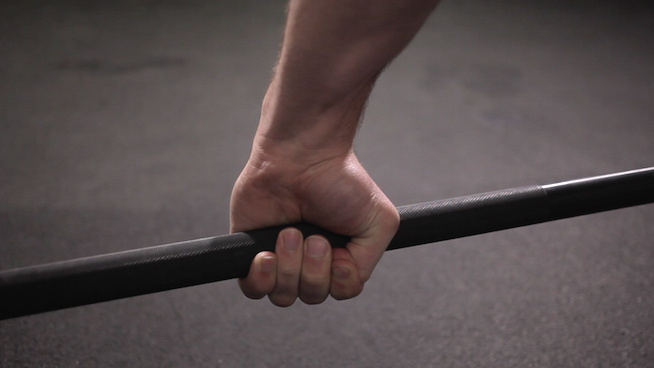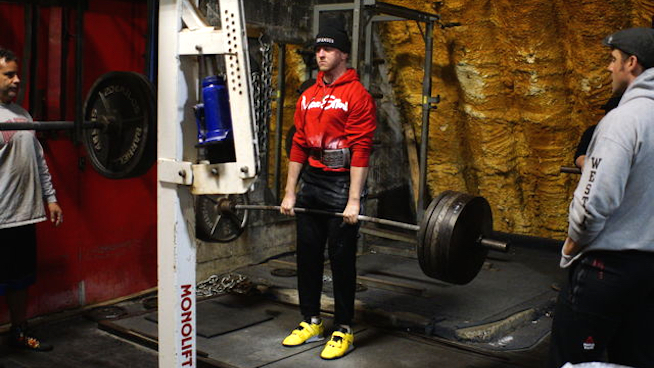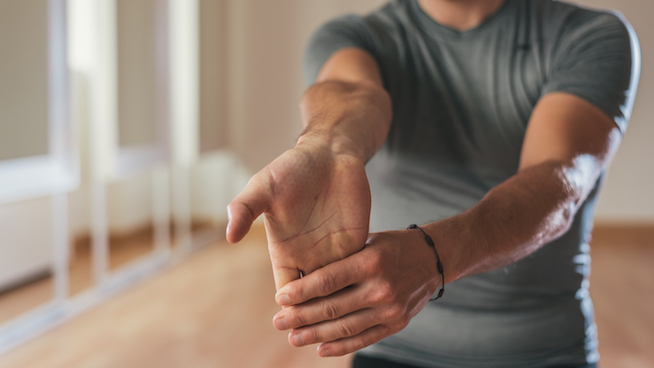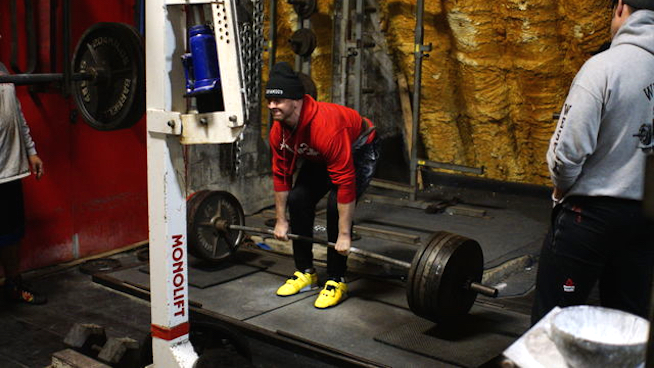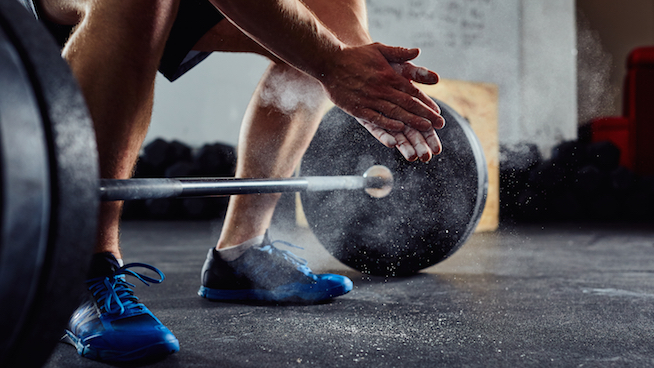The Hook Grip Deadlift: Why Every Lifter Should Know This Powerful Technique
Have you ever noticed that most people can Deadlift more weight with straps than without straps? Have you ever taken your final heavy Deadlift at the gym or in a powerlifting meet only to get it to the top and lose your grip?
Several months ago, I took my opening Deadlift of 485 pounds at a powerlifting meet, a weight that I could easily handle at the time, and got it to the top before I completely lost my grip and dropped the weight. In a powerlifting meet, if you lock the weight out but then drop it, it counts as a no lift. I would go on to not complete a Deadlift, and therefore bomb out of my meet and not put together a total. I had done a hard weight cut, and a very difficult training cycle before this, so this was very aggravating and humbling.
Well, there’s a solution to these problems. For me, it was called the Hook Grip Deadlift. I’m not saying it was easy, or that it didn’t hurt like hell the first few times I tried it, but I am saying it was worth it and that the hook grip has the potential to help you break through your current Deadlift plateau.
What is the Hook Grip Deadlift?
The Hook Grip Deadlift is a variation of the Deadlift where you wrap your four fingers, from your index finger to your pinky, over top of the bar and then wrap them over top of your thumb as well. By wrapping your fingers (particularly your index and middle fingers) over top of your thumb, you are assuring that the bar will stay in place and you will not lose your grip. The best way I like to explain this is that it should act almost like a pair of straps when you are pulling on the bar. Your thumb is trapped under your fingers and should stay there throughout the entire lift. The Hook Grip Deadlift was first made popular by Olympic lifters because they are not allowed to wear straps, and has been picked up by several professional powerlifters as well.
RELATED: 3 Grip Mistakes Undermining Your Bench Press, Deadlift and Lat Pulldowns
How Do I Start Hook Grip Deadlifting?
I began hook grip deadlifting by chance but also by necessity. We were working on some Deadlift positioning work one morning at Old School Gym during training, and Cory Gregory recommended that I should maybe try to Hook Grip Deadlift. He mentioned that since I was a conventional Deadlifter, it may help me get into a better position. When I was using a mixed grip, I was really struggling to get my lats engaged and also sit back and get my shoulders behind the bar. (For every inch your shoulders are in front of the bar, it subtracts roughly 10-15 pounds from your Deadlift). So, I tried the Hook Grip Deadlift and worked up to a really smooth 455-pound Deadlift and cut it there. At the time, that was a weight that I could get, but was not easy, so I knew I was onto something. Most people are much stronger than they believe they are, they just have to find the positioning that brings out their maximum strength.
Who is the Hook Grip Deadlift Best For?
I have found that the Hook Grip Deadlift is best for people with very long fingers and large hands. The long fingers do a great job of wrapping over top of your thumbs and trapping the thumb in place so it’s almost impossible to let go. It’s also important to have a thumb that’s long enough to trap. A lot of my training partners with smaller hands struggle to hold onto the bar throughout the lift because their fingers are not long enough to hold their thumbs in place. However I want to make something very clear: if you have small hands, it does not give you an excuse to struggle to hold onto the bar. It just means that you need to work harder on your grip strength. Once you lose your grip on a Hook Grip Deadlift, it turns into a double overhand grip, which is extremely difficult to hold on to.
What Are Some Benefits of the Hook Grip Deadlift?
As I stated earlier, one of the biggest benefits I noticed when I switched from a Mixed Grip Deadlift to a Hook Grip Deadlift was my positioning. I feel like I can sit back in a much better position where I am getting more drive from my hamstrings, which is the strongest part of the legs. My speed off the floor since I switched grips has been nasty! I used to struggle to get the bar moving, and now that is not a problem at all. One of the most important things you can do in powerlifting is to put yourself in the position where you are the strongest. Your strongest position may not be the same as your training partner’s so you have to do a lot of work to figure out what your’s is.
When I Hook Grip Deadlift, I also feel like my lats are in a much better position. One of the least-talked about parts of the Deadlift is the engagement in the lats, but I feel like it’s one of the most important. If your butt is flying up and you can’t keep your lats engaged to the bar, the likelihood of injury is much higher, and the amount you are going to be able to lift is going to decrease severely. When I use an alternated grip, I feel like only one side of my body is activated which can lead to a very crooked Deadlift! The other obvious benefit of the hook grip is that it allows for phenomenal grip strength and avoids the potential of biceps tears that comes from deadlifting with a supinated grip. I have Deadlifted with a hook grip for two meets now and have hit a personal best of 525 pounds and barely missed 550 pounds.
Should I Try the Hook Grip Deadlift?
My conclusion is that the Hook Grip Deadlift is far superior than the alternated grip deadlift for me. It helps me get in a better position and helps me create far more power off the floor. If you feel like your Deadlift is making no progress, and you have done everything you can to improve it, I would highly recommend giving the hook grip a try. Try starting on a dynamic Deadlift day and eventually you can work into mixing it in on a max effort day! The hook grip can be painful and awkward at first, but can offer great benefit once you become accustomed to it. Some experts recommend putting athletic tape on your thumbs to reduce discomfort when you’re first trying the Hook Grip Deadlift. It’s also important to remember that no gains are worth serious injury, so it’s up to you to see how well your hands (particularly your thumbs) handle this variation.
Photo Credit: BartekSzewczyk/iStock, emiliozv/iStock
READ MORE:
RECOMMENDED FOR YOU
MOST POPULAR
The Hook Grip Deadlift: Why Every Lifter Should Know This Powerful Technique
Have you ever noticed that most people can Deadlift more weight with straps than without straps? Have you ever taken your final heavy Deadlift at the gym or in a powerlifting meet only to get it to the top and lose your grip?
Several months ago, I took my opening Deadlift of 485 pounds at a powerlifting meet, a weight that I could easily handle at the time, and got it to the top before I completely lost my grip and dropped the weight. In a powerlifting meet, if you lock the weight out but then drop it, it counts as a no lift. I would go on to not complete a Deadlift, and therefore bomb out of my meet and not put together a total. I had done a hard weight cut, and a very difficult training cycle before this, so this was very aggravating and humbling.
Well, there’s a solution to these problems. For me, it was called the Hook Grip Deadlift. I’m not saying it was easy, or that it didn’t hurt like hell the first few times I tried it, but I am saying it was worth it and that the hook grip has the potential to help you break through your current Deadlift plateau.
What is the Hook Grip Deadlift?
The Hook Grip Deadlift is a variation of the Deadlift where you wrap your four fingers, from your index finger to your pinky, over top of the bar and then wrap them over top of your thumb as well. By wrapping your fingers (particularly your index and middle fingers) over top of your thumb, you are assuring that the bar will stay in place and you will not lose your grip. The best way I like to explain this is that it should act almost like a pair of straps when you are pulling on the bar. Your thumb is trapped under your fingers and should stay there throughout the entire lift. The Hook Grip Deadlift was first made popular by Olympic lifters because they are not allowed to wear straps, and has been picked up by several professional powerlifters as well.
RELATED: 3 Grip Mistakes Undermining Your Bench Press, Deadlift and Lat Pulldowns
How Do I Start Hook Grip Deadlifting?
I began hook grip deadlifting by chance but also by necessity. We were working on some Deadlift positioning work one morning at Old School Gym during training, and Cory Gregory recommended that I should maybe try to Hook Grip Deadlift. He mentioned that since I was a conventional Deadlifter, it may help me get into a better position. When I was using a mixed grip, I was really struggling to get my lats engaged and also sit back and get my shoulders behind the bar. (For every inch your shoulders are in front of the bar, it subtracts roughly 10-15 pounds from your Deadlift). So, I tried the Hook Grip Deadlift and worked up to a really smooth 455-pound Deadlift and cut it there. At the time, that was a weight that I could get, but was not easy, so I knew I was onto something. Most people are much stronger than they believe they are, they just have to find the positioning that brings out their maximum strength.
Who is the Hook Grip Deadlift Best For?
I have found that the Hook Grip Deadlift is best for people with very long fingers and large hands. The long fingers do a great job of wrapping over top of your thumbs and trapping the thumb in place so it’s almost impossible to let go. It’s also important to have a thumb that’s long enough to trap. A lot of my training partners with smaller hands struggle to hold onto the bar throughout the lift because their fingers are not long enough to hold their thumbs in place. However I want to make something very clear: if you have small hands, it does not give you an excuse to struggle to hold onto the bar. It just means that you need to work harder on your grip strength. Once you lose your grip on a Hook Grip Deadlift, it turns into a double overhand grip, which is extremely difficult to hold on to.
What Are Some Benefits of the Hook Grip Deadlift?
As I stated earlier, one of the biggest benefits I noticed when I switched from a Mixed Grip Deadlift to a Hook Grip Deadlift was my positioning. I feel like I can sit back in a much better position where I am getting more drive from my hamstrings, which is the strongest part of the legs. My speed off the floor since I switched grips has been nasty! I used to struggle to get the bar moving, and now that is not a problem at all. One of the most important things you can do in powerlifting is to put yourself in the position where you are the strongest. Your strongest position may not be the same as your training partner’s so you have to do a lot of work to figure out what your’s is.
When I Hook Grip Deadlift, I also feel like my lats are in a much better position. One of the least-talked about parts of the Deadlift is the engagement in the lats, but I feel like it’s one of the most important. If your butt is flying up and you can’t keep your lats engaged to the bar, the likelihood of injury is much higher, and the amount you are going to be able to lift is going to decrease severely. When I use an alternated grip, I feel like only one side of my body is activated which can lead to a very crooked Deadlift! The other obvious benefit of the hook grip is that it allows for phenomenal grip strength and avoids the potential of biceps tears that comes from deadlifting with a supinated grip. I have Deadlifted with a hook grip for two meets now and have hit a personal best of 525 pounds and barely missed 550 pounds.
Should I Try the Hook Grip Deadlift?
My conclusion is that the Hook Grip Deadlift is far superior than the alternated grip deadlift for me. It helps me get in a better position and helps me create far more power off the floor. If you feel like your Deadlift is making no progress, and you have done everything you can to improve it, I would highly recommend giving the hook grip a try. Try starting on a dynamic Deadlift day and eventually you can work into mixing it in on a max effort day! The hook grip can be painful and awkward at first, but can offer great benefit once you become accustomed to it. Some experts recommend putting athletic tape on your thumbs to reduce discomfort when you’re first trying the Hook Grip Deadlift. It’s also important to remember that no gains are worth serious injury, so it’s up to you to see how well your hands (particularly your thumbs) handle this variation.
Photo Credit: BartekSzewczyk/iStock, emiliozv/iStock
READ MORE:

